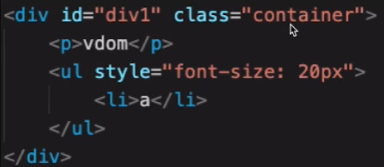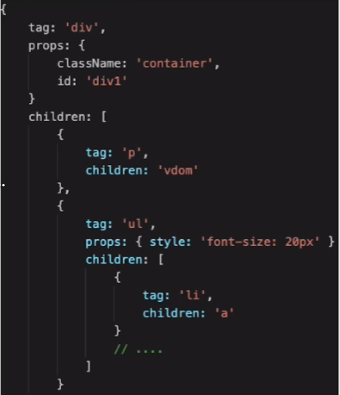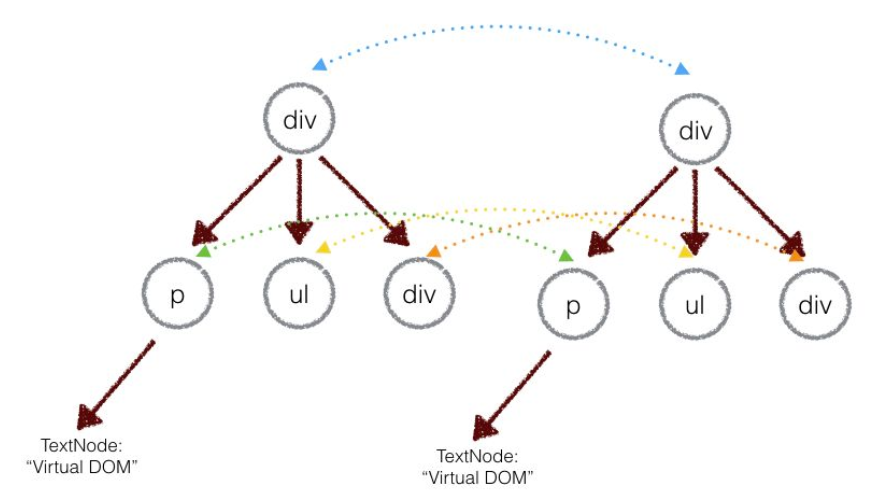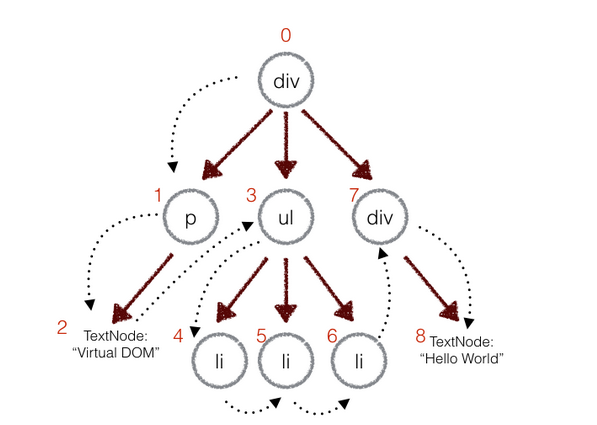虚拟DOM和diff算法 前言
用js模拟DOM结构:
为什么使用虚拟DOM,有什么好处 DOM是很慢的。如果我们把一个简单的div元素的属性都打印出来,你会看到:
而这仅仅是第一层。真正的 DOM 元素非常庞大,这是因为标准就是这么设计的。而且操作它们的时候你要小心翼翼,轻微的触碰可能就会导致页面重排,这可是杀死性能的罪魁祸首。
相对于 DOM 对象,原生的 JavaScript 对象处理起来更快,而且更简单 。DOM 树上的结构、属性信息我们都可以很容易地用 JavaScript 对象表示出来:
1 2 3 4 5 6 7 8 9 10 11 var element = { tagName : 'ul' , props : { id : 'list' }, children : [ {tagName : 'li' , props : {class : 'item' }, children : ["Item 1" ]}, {tagName : 'li' , props : {class : 'item' }, children : ["Item 2" ]}, {tagName : 'li' , props : {class : 'item' }, children : ["Item 3" ]}, ] }
上面对应的HTML写法是:
1 2 3 4 5 <ul id ='list' > <li class ='item' > Item 1</li > <li class ='item' > Item 2</li > <li class ='item' > Item 3</li > </ul >
既然原来 DOM 树的信息都可以用 JavaScript 对象来表示,反过来,你就可以根据这个用 JavaScript 对象表示的树结构来构建一棵真正的DOM树。用新渲染的对象树去和旧的树进行对比,记录这两棵树差异。记录下来的不同就是我们需要对页面真正的 DOM 操作,然后把它们应用在真正的 DOM 树上,页面就变更了。这样就可以做到:视图的结构确实是整个全新渲染了,但是也避免了没有必要的dom操作,从而提高性能。
这就是所谓的 Virtual DOM 算法。具体实现步骤:
用 JavaScript 对象结构表示 DOM 树的结构;然后用这个树构建一个真正的 DOM 树,插到文档当中
当状态变更的时候,重新构造一棵新的对象树。然后用新的树和旧的树进行比较,记录两棵树差异
把2所记录的差异应用到步骤1所构建的真正的DOM树上,视图就更新了
Virtual DOM 本质上就是在 JS 和 DOM 之间做了一个缓存 。可以类比 CPU 和硬盘,既然硬盘这么慢,我们就在它们之间加个缓存:既然 DOM 这么慢,我们就在它们 JS 和 DOM 之间加个缓存。CPU(JS)只操作内存(Virtual DOM),最后的时候再把变更写入硬盘(DOM)。
虚拟DOM 用算法实现虚拟DOM
1 2 3 4 5 6 7 8 9 10 11 12 13 14 15 16 17 18 19 20 21 22 23 function VDOM (tagName, props, children ) { this .tagName = tagName; this .props = props; this .children = children; } VDOM .prototype render = function ( var el = document .createElement (this .tagName ); for (var name in this .props ) { el.setAttribute (name, this .props [name]); } var children = this .children || []; for (var child of children) { var childEl = (child instanceof VDOM ) ? child.render () :document .createTextNode (child); el.appendChild (childEl); } return el; }
diff算法 比较两棵DOM树的差异是 Virtual DOM 算法最核心的部分,这也是所谓的 Virtual DOM 的 diff 算法。两个树的完全的 diff 算法是一个时间复杂度为 O(n^3) 的问题 。但是在前端当中,你很少会跨越层级地移动DOM元素。所以 Virtual DOM 只会对同一个层级的元素进行对比 :
上图中div只会和同一层级的div对比,第二层的只会跟第二层级对比。这样算法复杂度就到了O(n)
在深度优先遍历的时候,每遍历到一个节点就把该节点和新的的树进行对比。如果有差异的话就记录到一个对象里面。
diff.js 的简单代码实现 :
在同层进行比较时候会出现四种情况:
1、此节点是否被移除 -> 添加新的节点
最后返回一个patch对象用来应用到实际的DOM tree更新,它的结构是这样的:
1 2 patches = {index :[{type : utils.REMOVE /utils.TEXT /utils.ATTRS /utils.REPLACE , index/content/attrs/node : }, ...], ...}
1 2 3 4 5 6 7 8 9 10 11 12 13 14 15 16 17 18 19 20 21 22 23 24 25 26 27 28 29 30 31 32 33 34 35 36 37 38 39 40 41 42 43 44 45 46 47 48 49 50 51 52 53 54 55 56 57 58 59 60 61 62 63 64 let utils = require ('./utils' );let keyIndex = 0 ;function diff (oldTree, newTree ) { let patches = {}; keyIndex = 0 ; let index = 0 ; walk (oldTree, newTree, index, patches); return patches; } function walk (oldNode, newNode, index, patches ) { let currentPatches = []; if (!newNode) { currentPatches.push ({type : utils.REMOVE , index}); } else if (utils.isString (oldNode) && utils.isString (newNode)) { if (oldNode != newNode) { currentPatches.push ({type : utils.TEXT , content : newNode}); } } else if (oldNode.tagName == newNode.tagName ) { let attrsPatch = diffAttr (oldNode.attrs , newNode.attrs ); if (Object .keys (attrsPatch).length > 0 ) { currentPatches.push ({type : utils.ATTRS , attrs : attrsPatch}); } diffChildren (oldNode.children , newNode.children , index, patches, currentPatches); } else { currentPatches.push ({type : utils.REPLACE , node : newNode}); } if (currentPatches.length > 0 ) { patches[index] = currentPatches; } } function diffChildren (oldChildren, newChildren, index, patches, currentPatches ) { oldChildren.forEach ((child, idx ) => { walk (child, newChildren[idx], ++keyIndex, patches); }); } function diffAttr (oldAttrs, newAttrs ) { let attrsPatch = {}; for (let attr in oldAttrs) { if (oldAttrs[attr] != newAttrs[attr]) { attrsPatch[attr] = newAttrs[attr]; } } for (let attr in newAttrs) { if (!oldAttrs.hasOwnProperty (attr)) { attrsPatch[attr] = newAttrs[attr]; } } return attrsPatch; } module .exports = diff;
patch.js的简单实现 把差异应用到真正的DOM树上
1 2 3 4 5 6 7 8 9 10 11 12 13 14 15 16 17 18 19 20 21 22 23 24 25 26 27 28 29 30 31 32 33 34 35 36 37 38 39 40 41 42 let keyIndex = 0 ;let utils = require ('./utils' );let allPatches;function patch (root, patches ) { allPatches = patches; walk (root); } function walk (node ) { let currentPatches = allPatches[keyIndex++]; (node.childNodes || []).forEach (child =>walk (child)); if (currentPatches) { doPatch (node, currentPatches); } } function doPatch (node, currentPatches ) { currentPatches.forEach (patch => switch (patch.type ) { case utils.ATTRS : for (let attr in patch.attrs ) { let value = patch.attrs [attr]; if (value) { utils.setAttr (node, attr, value); } else { node.removeAttribute (attr); } } break ; case utils.TEXT : node.textContent = patch.content ; break ; case utils.REPLACE : let newNode = (patch.node instanceof Element ) ? path.node .render () : document .createTextNode (path.node ); node.parentNode .replaceChild (newNode, node); break ; case utils.REMOVE : node.parentNode .removeChild (node); break ; } }); } module .exports = patch;
结语 Virtual DOM 算法主要是实现上面步骤的三个函数:VDOM、diff、patch。然后就可以实际的进行使用:
1 2 3 4 5 6 7 8 9 10 11 12 13 14 15 16 17 18 19 20 21 22 23 var tree = el ('div' , {'id' : 'container' }, [ el ('h1' , {style : 'color: blue' }, ['simple virtal dom' ]), el ('p' , ['Hello, virtual-dom' ]), el ('ul' , [el ('li' )]) ]) var root = tree.render ()document .body .appendChild (root)var newTree = el ('div' , {'id' : 'container' }, [ el ('h1' , {style : 'color: red' }, ['simple virtal dom' ]), el ('p' , ['Hello, virtual-dom' ]), el ('ul' , [el ('li' ), el ('li' )]) ]) var patches = diff (tree, newTree)patch (root, patches)
最后,推荐一个vdom库:snabbdom ,vue参考它实现的vdom和diff
参考文章:https://www.zhihu.com/question/29504639?sort=created







